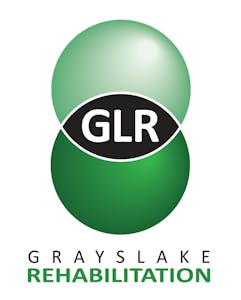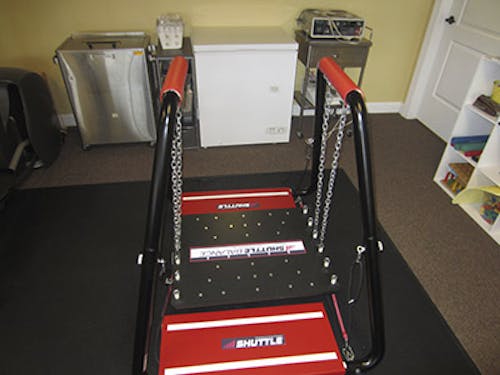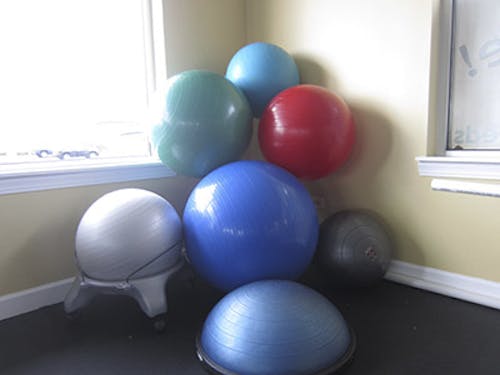
Sports Medicine has to do with prevention, diagnosis, and treatment of injuries sustained during athletic activities. Grayslake Rehabilitation, Physical Therapy & Wellness has developed a program to help athletes with their athletic injuries. There are two areas of Sports Medicinethat we focus on: prevention and treatment.
Preventing injury before it occurs is the most ideal situation for athletes. Injuries involve missed time on the playing field and do not always heal exactly the way they once were. For these reasons it is important to take necessary measures to prevent injury. Grayslake Rehabilitation, Physical Therapy & Wellness accomplishes this through their Injury Prevention Program, which has helped countless athletes prepare themselves for athletic competition and reduce the risk of injury, helping them to succeed.
The second aspect of Sports Medicine that Grayslake Rehabilitation, Physical Therapy & Wellness specializes in is treatment of athletic injuries. It is important for an injured athlete to be able to return to competition as quickly as possible, while ensuring that their injury has fully healed. The sequence of proper injury rehabilitation includes: pain management, recovering and improving the joint’s range of motion, increasing muscular tone and strength, introducing weight-bearing exercises and strengthening, and finally sports-specific training. Another aspect of the rehabilitation process that is included throughout is maintaining cardio-respiratory fitness, so that an athlete is able to return to competition in proper condition.
Through evidence-based techniques, our Physical Therapists are trained to effectively treat athletic injuries and ensure a complete recovery so that the athlete can continue to compete in their sport.
Many athletes suffer from knee pain at one point or another during their career. One common condition that can be cured is called patellofemoral pain syndrome. This is just one example of an athletic injury that is successfully treated at Grayslake Rehabilitation, Physical Therapy & Wellness.
Knee Pain and Running – Patellofemoral Pain Syndrome
Forty–two percent of all overuse injuries affect the knee joint and patellofemoral pain syndrome (PFPS), also known as “runner’s knee,” is the most common overuse injury among runners. PFPS can affect one or both knees. It strikes mostly younger, recreational runners, and twice as many women as men, according to the British Journal of Sports Medicine. (Women tend to have wider hips, resulting in a greater angling of the thighbone to the knee, which puts the kneecap under more stress.) It occurs when your kneecap “patella” does not track properly in its femoral groove.
What are the symptoms of PFPS?
Symptoms include tenderness behind or around the patella, usually toward its center. You may feel pain toward the back of the knee, a sense of cracking or that the knee is giving out. Steps, hills, and uneven surfaces can aggravate PFPS.
What causes PFPS?
Pinpointing a single cause can be challenging but a Physical Therapist can assess your knee and evaluate what the cause may be contributing to your pain. Anterior knee pain could be a biomechanical problem (i.e., excessive internal rotation of your hip or your kneecap may sit too high or too low in its groove) could be due to worn cartilage in the knee joint which reduces shock absorption, high arches of the feet provide less cushioning and flat feet or knees that turn in or out excessively can pull the patella sideways. There are also muscular causes. Tight hamstrings and calf muscles can put imbalanced pressures on the knee and weak quadricep muscles can cause the patella to track out of alignment.
What can I do to help with PFPS?
At Grayslake Rehabilitation, Physical Therapy & Wellness we can perform a thorough assessment and determine what factors could be contributing to your knee pain. We also evaluate your running stride while running on the treadmill to determine if there are any problems with your running technique which may be the culprit of your pain. Treatment will consist of exercises to focus on correcting existing muscle imbalances, a flexibility program for the hamstrings, calves and hip flexors, education on proper footwear and referral for orthotics to correct your foot positioning, if necessary. If your feet have good form, your knees will follow.
To help prevent PFPS, run on softer surfaces, keep mileage increases to less than 10 percent per week and gradually increase your hill work in your program. You should also contact a Physical Therapist for an exercise program to focus on increasing the strength of your quadriceps muscles, hip rotators and stabilizers and your feet.
Contact our office at 847.986.3580 or by e-Mail for any further questions or to schedule an appointment with one of our Physical Therapists.






